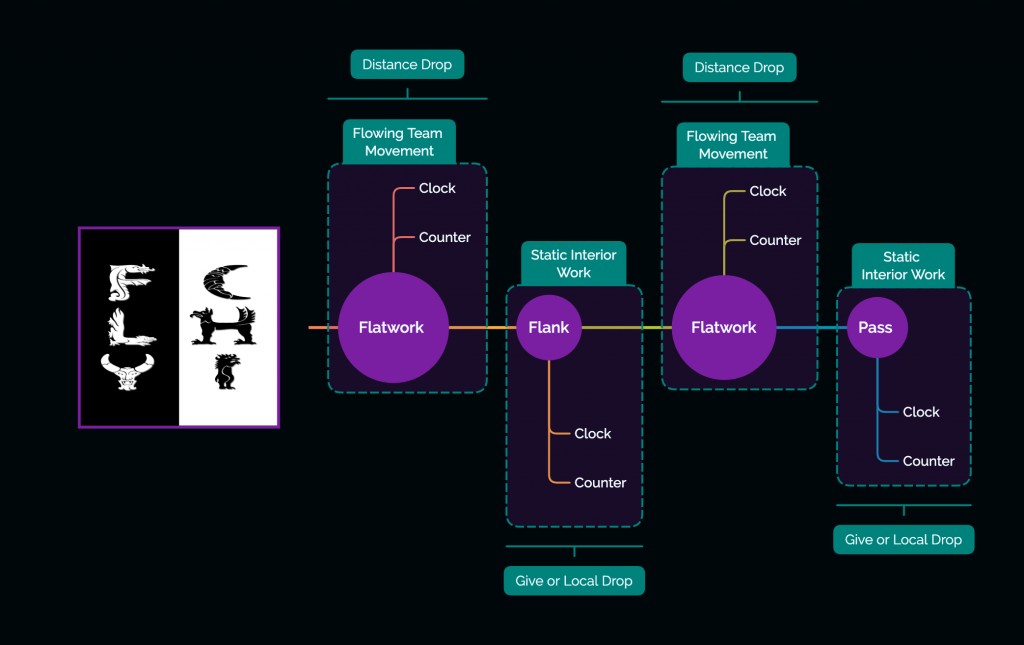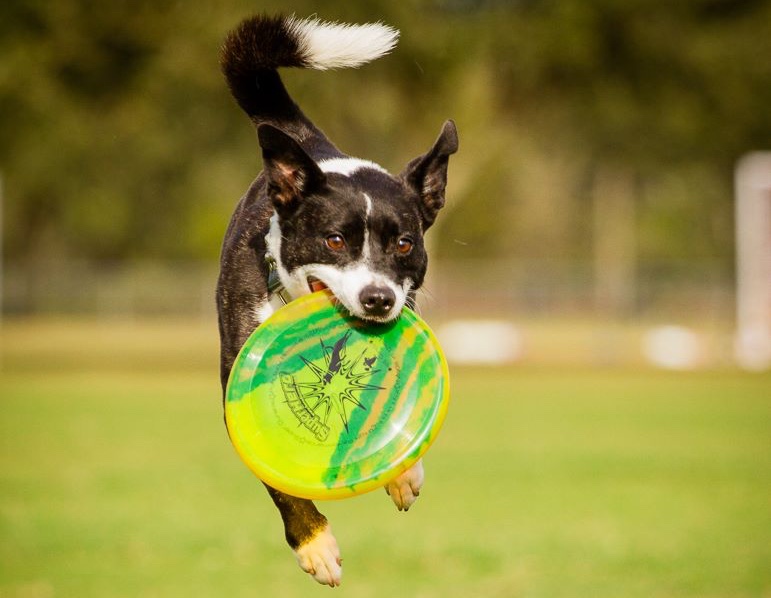
Fly Chi Flow Forms as Drop Framework
The other day I was working with Elliegator on Fly Chi Flow Flow is a key component of the modern day disc dog game. Keeping your dog moving with seamless, ever moving and flowing sequences with little to no set up time is the goal... More Form #2, which is a tricky little form that features alternating clock and counter crossing passes, two static flanking throws from the Flatwork Compass
Flow is a key component of the modern day disc dog game. Keeping your dog moving with seamless, ever moving and flowing sequences with little to no set up time is the goal... More Form #2, which is a tricky little form that features alternating clock and counter crossing passes, two static flanking throws from the Flatwork Compass The Flatwork Compass is a disc dog form that separates the Flank from the Pass, creates a reliable trigger, and exposes the team to all of the key elements of Team Movement. https://www.youtube.com/watch?v=xW7Czz-7ows&list=PL8zWXaJfi1-synGOkBJ7u4p-WkotsL3LR... More (2 o clock & 10 o clock), two more alternating crossing passes, then 2 static passing throws, clock and counter, from the Flatwork
The Flatwork Compass is a disc dog form that separates the Flank from the Pass, creates a reliable trigger, and exposes the team to all of the key elements of Team Movement. https://www.youtube.com/watch?v=xW7Czz-7ows&list=PL8zWXaJfi1-synGOkBJ7u4p-WkotsL3LR... More (2 o clock & 10 o clock), two more alternating crossing passes, then 2 static passing throws, clock and counter, from the Flatwork Flatwork is the stuff that happens between the catches. How the team moves and transitions, often without the disc, is flatwork. Flatwork concepts in disc dog are taken from the agility and herding... More Compass.
Flatwork is the stuff that happens between the catches. How the team moves and transitions, often without the disc, is flatwork. Flatwork concepts in disc dog are taken from the agility and herding... More Compass.
Fly Chi Flow forms connect flatwork and Team MovementTeam Movement is how dog and handler move, as a team, out there on the field. It is a judging category in some organizations and certainly is a focus of many judges, players,... More to the foundational static expressions of connection of the Flatwork Compass. They are amazing frameworks for learning how teams move and for exercising communication and control with your dog.
I have known that they were good frameworks for exercising the cued Drop, but I had no idea just how clean and efficient these forms are when applied towards reinforcing a cued Drop.

Drop at a Distance Create & Capture Opportunity
The flatwork portions of the forms provide terrific opportunities for the dog, handler, and team to reinforce a cued Drop at a distance.
If your dog already drops at a distance, the presentation of BFP (Basic Flatwork Position Basic Flatwork Position (BFP) is a standard position of the handler in the Working Flank; hand reaching out towards the dog (usually with a disc) with the dog on the same plane as... More) to hook up with the dog and subsequent Team Movement leading to a throw can and will be taken as a cookie, and can and will reinforce your cued Drop.
Basic Flatwork Position (BFP) is a standard position of the handler in the Working Flank; hand reaching out towards the dog (usually with a disc) with the dog on the same plane as... More) to hook up with the dog and subsequent Team Movement leading to a throw can and will be taken as a cookie, and can and will reinforce your cued Drop.
If your dog does not drop at a distance, the presentation of BFP can provide a moment of opportunity that reinforces the Drop. Many dogs drop on opportunity and this common “problem” can be used to pair opportunity with your Drop cue.
This can be done in Prompt SwitchA Prompt Switch is a technique for changing the cue or signal for a behavior. The new/weak cue is given, verbally or physically followed immediately by the old/strong cue. Then the behavior happens.... More fashion, where the cue is simply paired with the action – cue then do – and the dog who drops on opportunity will spit the disc out right after hearing the cue. Do this enough and the verbal cue that precedes the physical BFP signal will become much stronger and will work on it’s own.
Local Drop or Give
The Flank Out to the side of the handler is the Flank. If the dog is out to the handler's right or left the dog is on Flank. If the dog is moving with the... More and Pass
Out to the side of the handler is the Flank. If the dog is out to the handler's right or left the dog is on Flank. If the dog is moving with the... More and Pass A Pass or Passing is a linear Team Movement maneuver that has the dog running or moving past the handler in close proximity, crossing or breaking the plane of the handler's body. portions of this form start in close proximity to the handler. By withholding your Drop cue until the dog is right next to the handler or by employing a Give
A Pass or Passing is a linear Team Movement maneuver that has the dog running or moving past the handler in close proximity, crossing or breaking the plane of the handler's body. portions of this form start in close proximity to the handler. By withholding your Drop cue until the dog is right next to the handler or by employing a Give The Give is a retrieve to the hand. A cued Give is a foundational skill that is not super useful in the actual performance of disc dog freestyle, and has huge applications for... More on these static moves, the handler can create a non-example of the Drop at a distance which is tremendously helpful to create a full and clear picture of the cued Drop.
The Give is a retrieve to the hand. A cued Give is a foundational skill that is not super useful in the actual performance of disc dog freestyle, and has huge applications for... More on these static moves, the handler can create a non-example of the Drop at a distance which is tremendously helpful to create a full and clear picture of the cued Drop.
One of the big problems with gaining stimulus control over the Drop or extending the range of your cued Drop is that the dog doesn’t understand that the Drop can happen anywhere. This lack of understanding is reinforced and perpetuated when the team struggles to Drop on cue.
This constant struggle puts pressure on the skill and the Drop is often reflexively cued and performed at a standard distance and/or builds in a standard latency – the handler cues it and the dog does it after a certain number of strides or several seconds later. The standardized distance and/or built in latency of this work leads to the dog not understanding that it is the verbal cue that means teeth off, but it is instead a distance or positional pressure based signal that leads to the Drop.
Taking the pressure off dropping at a distance and allowing or expecting the dog to come all the way in before performing the Drop or asking for a Give can provide a big picture epiphany to the dog,”OHHH!!! You mean I can drop it anywhere? I had no idea that word meant that…”
The local Drops also can be used to eliminate latency between the Drop cue and teeth off, which is great reinforcement of the Drop at a distance.
Fly Chi Flow Form #2 – Tough on the Drop
Fly Chi Flow Form #2 is a tricky little form. It requires a strong read of the dog’s direction and a little waggle on one of the alternating flatwork flanks. This requirement to read and handle the dog creates a difficult multitasking situation for the handler, and a difficult to hit drop window for the team. You can see me struggle with this in the video below.
This difficulty led me to teach that Flow Form #2 should only be used with a dog who drops early or who has a strong drop already. I didn’t understand that the Form actually could be used to reinforce the cued Drop. I didn’t get the idea that the strong, Front Cross On a Front Cross, your dog switches Flanks in with you in front of them. From Clock to Counter Clockwise Flank or vice versa. Taken directly from the canine agility world, the Front... More movement could be used as an opportunity and paired with the Drop cue as a Prompt Switch. This new understanding gives me another tool in the toolbox and a very strong framework for working on the Drop.
On a Front Cross, your dog switches Flanks in with you in front of them. From Clock to Counter Clockwise Flank or vice versa. Taken directly from the canine agility world, the Front... More movement could be used as an opportunity and paired with the Drop cue as a Prompt Switch. This new understanding gives me another tool in the toolbox and a very strong framework for working on the Drop.
One of the tough things with concentrated work on the Drop is that it can be very tedious and boring for the dog, handler, and team. Adding Fly Chi Flow forms to the mix changes that.
You can get your Drop, exercise Flatwork & Team Movement, and have your jam too… Woohoo!








Responses